SORA Always Available Books: Young Adult Fiction
"Always Available" books are available for checkout to an unlimited number of students at the same time.
YA Fiction
Books are listed alphabetically by author's last name. Click the letter below to tab down to that letter.
A - B - C - D - E - F - G - H - I - J - K - L - M - O - P - R - S - T - V - W
A
 The Candy Country by ISBN: 9781522859437The Candy Country is about a girl named Lily who takes her mother's big red umbrella and ends up blown into Candy country. She finds herself going on more adventures through a land of gingerbread, cakes and cookies until ending up enjoying the land of wholesome bread. Her adventures teach her to become a good housekeeper and enjoy sweet only at Christmas time.
The Candy Country by ISBN: 9781522859437The Candy Country is about a girl named Lily who takes her mother's big red umbrella and ends up blown into Candy country. She finds herself going on more adventures through a land of gingerbread, cakes and cookies until ending up enjoying the land of wholesome bread. Her adventures teach her to become a good housekeeper and enjoy sweet only at Christmas time. Flower Fables by ISBN: 9780966093308A collection of her lesser known work, Flower Fables contains wildly imaginative stories that grew out of Alcott's experience as a storyteller to the children of her Concord, Connecticut, neighbors. Through these enticing encounters with fairies, elves, and animals, the author creates a foundation for young people based on the themes of love, kindness, and responsibility.
Flower Fables by ISBN: 9780966093308A collection of her lesser known work, Flower Fables contains wildly imaginative stories that grew out of Alcott's experience as a storyteller to the children of her Concord, Connecticut, neighbors. Through these enticing encounters with fairies, elves, and animals, the author creates a foundation for young people based on the themes of love, kindness, and responsibility.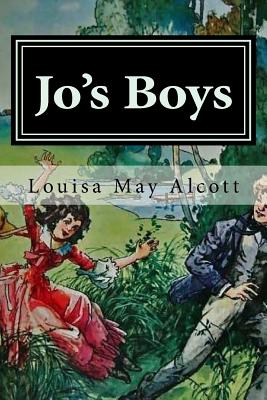 Jo's Boys by ISBN: 9780448060132This sequel to Alcott's "Little Women" and "Little Men" chronicles the return of the classmates of Plumfield, Jo's school for boys. Readers reencounter Nat, the orphaned street musician, now a conservatory student; restless Dan, back from the gold mines of California; business-minded Tom; and other old friends.
Jo's Boys by ISBN: 9780448060132This sequel to Alcott's "Little Women" and "Little Men" chronicles the return of the classmates of Plumfield, Jo's school for boys. Readers reencounter Nat, the orphaned street musician, now a conservatory student; restless Dan, back from the gold mines of California; business-minded Tom; and other old friends.Little Men by
ISBN: 9781421818009Please, sir, is this Plumfield? asked a ragged boy of the man who opened the great gate at which the omnibus left him. Yes. Who sent you? Mr. Laurence. I have got a letter for the lady. All right; go up to the house, and give it to her; she'll see to you, little chap. The man spoke pleasantly, and the boy went on, feeling much cheered by the words. Through the soft spring rain that fell on sprouting grass and budding trees, Nat saw large square house before him a hospitable-looking house, with an old-fashioned porch, wide steps, and lights shining in many win-dows. Neither curtains nor shutters hid the cheerful glimmer; and, pausing a moment before he rang, Nat saw many little shadows dancing on the walls, heard the pleasant hum of young voices, and felt that it was hardly possible that the light and warmth and comfort within could be for a homeless little chap like him.Little Women by
ISBN: 9781503280298Little Women is a novel by American author Louisa May Alcott (1832-1888), which was originally published in two volumes in 1868 and 1869. Alcott wrote the books rapidly over several months at the request of her publisher. The novel follows the lives of four sisters-Meg, Jo, Beth, and Amy March-detailing their passage from childhood to womanhood, and is loosely based on the author and her three sistersA Modern Cinderella by
ISBN: 9781421819990Among green New England hills stood an ancient house, many-gabled, mossy-roofed, and quaintly built, but picturesque and pleasant to the eye; for a brook ran babbling through the orchard that encompassed it about, a garden-plat stretched upward to the whispering birches on the slope, and patriarchal elms stood sentinel upon the lawn, as they had stood almost a century ago, when the Revoiution rolled that way and found them young. One summer morning, when the air was full of country sounds, of mowers in the meadow, black-birds by the brook, and the low of kine upon the hill-side, the old house wore its cheeriest aspect, and a certain humble history began. Emma by ISBN: 9780140430103Emma, the fourth novel by Jane Austen, is set in Highbury, England, in the early 19th century. The novel centers on Emma Woodhouse, a precocious young woman whose misplaced confidence in her matchmaking abilities occasions several romantic misadventures.
Emma by ISBN: 9780140430103Emma, the fourth novel by Jane Austen, is set in Highbury, England, in the early 19th century. The novel centers on Emma Woodhouse, a precocious young woman whose misplaced confidence in her matchmaking abilities occasions several romantic misadventures. Pride and Prejudice by ISBN: 9780143036234When Elizabeth Bennet first meets eligible bachelor Fitzwilliam Darcy, she thinks him arrogant and conceited; he is indifferent to her good looks and lively mind. When she later discovers that Darcy has involved himself in the troubled relationship between his friend Bingley and her beloved sister Jane, she is determined to dislike him more than ever. In the sparkling comedy of manners that follows, Jane Austen shows the folly of judging by first impressions and superbly evokes the friendships, gossip and snobberies of provincial middle-class life.
Pride and Prejudice by ISBN: 9780143036234When Elizabeth Bennet first meets eligible bachelor Fitzwilliam Darcy, she thinks him arrogant and conceited; he is indifferent to her good looks and lively mind. When she later discovers that Darcy has involved himself in the troubled relationship between his friend Bingley and her beloved sister Jane, she is determined to dislike him more than ever. In the sparkling comedy of manners that follows, Jane Austen shows the folly of judging by first impressions and superbly evokes the friendships, gossip and snobberies of provincial middle-class life.Sense and Sensibility by
ISBN: 9781586178383What are two sisters of uncertain fortunes to do when the death of their father exiles their family to live in the countryside of southwestern England? Why, fall in love, of course! Through her deft unraveling of the dramatically different romantic fates of Elinor and Marianne Dashwood, Jane Austen displays her singular mastery of the English language and her equally masterful invention of colorful and realistic characters. The author's appreciation of what it is to be human, grounded in her deeply convicted Christianity, illuminates the tale with special wisdom. In this, her first published novel, we see the sense and sensibility of Miss Austen herself, which combine to form the brilliance that shines forth in all of her works--a brilliance enlivened by her remarkable sense of humor and the affectionate kindness that could only be born of a gracious Christian spirit.
 The Thirty-Nine Steps by ISBN: 9780141441177Publication Date: 2004-09-07A gripping tale of adventure that has enthralled readers since it was first published, John Buchan's The Thirty-Nine Steps is edited with an introduction and notes by Sir John Keegan in Penguin Classics. Adventurer Richard Hannay has just returned from South Africa and is thoroughly bored with his London life - until a spy is murdered in his flat, just days after having warned Hannay of an assassination plot that could plunge Britain into a war with Germany. An obvious suspect for the police and an easy target for the killers, Hannay picks up the trail left by the assassins, fleeing to Scotland, where he must use all his wits to stay one step ahead of the game - and warn the government before it is too late.
The Thirty-Nine Steps by ISBN: 9780141441177Publication Date: 2004-09-07A gripping tale of adventure that has enthralled readers since it was first published, John Buchan's The Thirty-Nine Steps is edited with an introduction and notes by Sir John Keegan in Penguin Classics. Adventurer Richard Hannay has just returned from South Africa and is thoroughly bored with his London life - until a spy is murdered in his flat, just days after having warned Hannay of an assassination plot that could plunge Britain into a war with Germany. An obvious suspect for the police and an easy target for the killers, Hannay picks up the trail left by the assassins, fleeing to Scotland, where he must use all his wits to stay one step ahead of the game - and warn the government before it is too late.Little Lord Fauntleroy by
ISBN: 9780192829610Little Lord Fauntleroy, which sold one million copies on its first publication in 1886, is the engaging, amusing, and moving story of a boy living on the edge of poverty in New York who suddenly learns that he is the heir to an English lord with vast lands and wealth.The Lost Prince by
ISBN: 9781497467279Marco Loristan's father, Stefan, is a Samavian patriot working to overthrow the cruel dictatorship in the kingdom of Samavia. Marco and his father come to London where Marco strikes up a friendship with a crippled street urchin known as "The Rat". The friendship occurs when Marco overhears The Rat shouting in military form. Marco discovers he had stumbled upon a strangely militia-like club known as the Squad.Stefan, realizing that two boys are less likely to be noticed, entrusts them with a secret mission to travel across Europe giving the secret sign: 'The Lamp is lighted.' Marco is to go as the Bearer of the sign while Rat goes as his Aide-de-Camp.This brings about a revolution which succeeds in overthrowing the old regime and re-establishing the rightful king. When Marco and The Rat return to London, Stefan has already left for Samavia. They wait there with his father's faithful bodyguard, Lazarus, until Stefan calls. The book ends in a climactic scene as Marco realizes his father is the descendant of Ivor Fedorovitch and thus the rightful king of Samavia.The Chessmen of Mars by
ISBN: 9781421807157Impetuous and headstrong, Tara, Princess of Helium and daughter of John Carter, defies the elements by flying into a rare, fierce Martian storm. Hurtled half a planet from her home she is threatened by grotesque, flesh eating monsters and barbarous warriors.The Land that Time Forgot by
ISBN: 9781421807188Starting out as a harrowing wartime sea adventure, The Land That Time Forgot ultimately develops into a lost world story reminiscent of such novels as Doyle's The Lost World and Jules Verne's The Mysterious Island. Bowen Tyler is an American captured at sea by a German U-boat and then finally stranded on an island called Caprona that is a veritable lost world filled with dinosaurs and danger.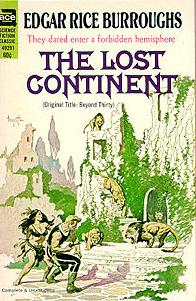 The Lost Continent by ISBN: 9780441492961Edgar Rice Burroughs was born in Chicago, Illinois in 1875. After serving a short time in the 7th U.S. Cavalry, Burroughs was a shopkeeper, gold miner, cowboy, and policeman before becoming a full-time writer. His first novel, Tarzan of the Apes, was published in 1914, and along with its 22 sequels has sold over 30 million copies in 58 languages. Author of numerous other jungle and science fiction novels and novellas, including The Land That Time Forgot, Burroughs had a writing career that spanned almost 30 years, with his last novel, The Land of Terror, being published in 1941. He died in 1950 at his ranch near Tarzana, the California town named for his legendary hero.
The Lost Continent by ISBN: 9780441492961Edgar Rice Burroughs was born in Chicago, Illinois in 1875. After serving a short time in the 7th U.S. Cavalry, Burroughs was a shopkeeper, gold miner, cowboy, and policeman before becoming a full-time writer. His first novel, Tarzan of the Apes, was published in 1914, and along with its 22 sequels has sold over 30 million copies in 58 languages. Author of numerous other jungle and science fiction novels and novellas, including The Land That Time Forgot, Burroughs had a writing career that spanned almost 30 years, with his last novel, The Land of Terror, being published in 1941. He died in 1950 at his ranch near Tarzana, the California town named for his legendary hero.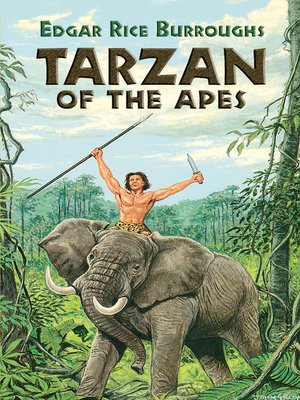 Tarzan of the Apes by ISBN: 9780199542888'I am Tarzan, King of the Apes, mighty hunter, mighty fighter. In all the jungle there is none so great.'Tarzan first came swinging through the jungle in the pages of a pulp-fiction magazine in 1912, and subsequently in the novel that went on to spawn numerous film and other adaptations. The infant Tarzan is orphaned after his parents are marooned and killed on the coast of West Africa. Adopted by anape-mother, Tarzan grows up to become a model of physical strength and natural prowess, and eventually leader of his tribe. When he encounters a group of white Europeans, and rescues Jane Porter from a marauding ape, he finds love, and must choose between the values of civilization and the jungle.The Tarzan of popular imagination bears only limited resemblance to Edgar Rice Burroughs's creation, and the complex backdrop of colonial appropriation, literary heritage, and nostalgic yearning from which he emerged. This edition considers these contexts, as well as the enduring appeal of the Kingof the Apes.
Tarzan of the Apes by ISBN: 9780199542888'I am Tarzan, King of the Apes, mighty hunter, mighty fighter. In all the jungle there is none so great.'Tarzan first came swinging through the jungle in the pages of a pulp-fiction magazine in 1912, and subsequently in the novel that went on to spawn numerous film and other adaptations. The infant Tarzan is orphaned after his parents are marooned and killed on the coast of West Africa. Adopted by anape-mother, Tarzan grows up to become a model of physical strength and natural prowess, and eventually leader of his tribe. When he encounters a group of white Europeans, and rescues Jane Porter from a marauding ape, he finds love, and must choose between the values of civilization and the jungle.The Tarzan of popular imagination bears only limited resemblance to Edgar Rice Burroughs's creation, and the complex backdrop of colonial appropriation, literary heritage, and nostalgic yearning from which he emerged. This edition considers these contexts, as well as the enduring appeal of the Kingof the Apes.
 Alice's Adventures in Wonderland by ISBN: 9780194227230
Alice's Adventures in Wonderland by ISBN: 9780194227230 The Ancient Mariner by ISBN: 9781904634140
The Ancient Mariner by ISBN: 9781904634140The King of Ireland's Son by
ISBN: 9781479314782Without doubt, The King of Ireland's Son is the best of Padraic Colum's books. Originally published in 1916, this classic has stood the test of time and remains one of the greatest set of tales ever-full of humor, imagination and drama. This edition has been freshly typeset in a modern font, as well as carefully edited, annotated and endnoted, allowing the reader to enter fully into all the often playful subtlety of meaning Colum gives to the names, places and objects in the tale. In addition, the pronunciation of the Irish and Celtic names and words has been noted, often with a background note or two as to their meaning. These are no stories retold by an academic or scholar, but rousing, living tales recounted from Colum's own childhood in Ireland. There, as a boy, he heard firsthand the myths and sagas, folk and fairy tales from itinerant storytellers who wandered the roads and told their stories in exchange for a roof over their heads and a bite to eat. He was a witness to the last generation of a long tradition stretching far back into the mists of time. Colum won awards and recognition aplenty for his work in his adopted country, the United States, and for the whole of his long life he carried on the storyteller's tradition. Even now, though he is long gone from us, his voice still sounds fresh and clear and full of life through the written text. Willy Pogany, a Hungarian artist, was a contemporary of Colum. He illustrated this volume with a wonderful sense of artistic fantasy and playfulness.The Deerslayer by
ISBN: 9780758333872The deadly crack of a long rifle and the piercing cries of Indians on the warpath shatter the serenity of beautiful lake Glimmerglass. Danger has invaded the vast forests of upper New York State as Deerslayer and his loyal Mohican friend Chingachgook attempt the daring rescue of an Indian maiden imprisoned in a Huron camp. Soon they are caught in the crossfire between a cunning enemy and two white bounty hunters who mercilessly kill for profit. The last of the Leatherstocking tales to be written, though first in the chronology of the hero's life, "The Deerslayer" is James Fenimore Cooper's masterpiece. A fine combination of romance, adventure, and morality; this classic novel of the frontier is an eloquent beginning for Cooper's great wilderness saga--and an unforgettable introduction to the famous character who has said to embody the conscience of America: the noble woodsman Deerslayer.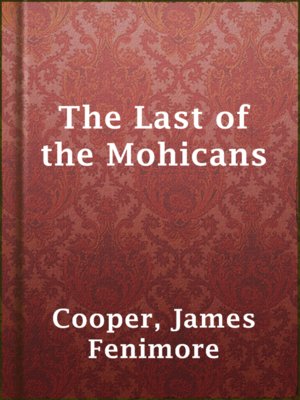 The Last of the Mohicans by ISBN: 9780140390247Angered by the values of his materialistic society, Hawk-eye lives apart from the other white men, sharing the solitude and sublimity of the wilderness with his Mohican Indian friend, Chingachgook. As the savageries of war test these exiled men, they agree to guide two sisters in search of their father through hostile Indian country - even if it means risking everything. An enduring American classic, The Last of the Mohicans is a fast-paced portrait of fierce individualism and courage, set against massacres, raids, battles and a doomed love affair. It is also the unforgettable story of the friendship between two men.
The Last of the Mohicans by ISBN: 9780140390247Angered by the values of his materialistic society, Hawk-eye lives apart from the other white men, sharing the solitude and sublimity of the wilderness with his Mohican Indian friend, Chingachgook. As the savageries of war test these exiled men, they agree to guide two sisters in search of their father through hostile Indian country - even if it means risking everything. An enduring American classic, The Last of the Mohicans is a fast-paced portrait of fierce individualism and courage, set against massacres, raids, battles and a doomed love affair. It is also the unforgettable story of the friendship between two men.The Spy by
ISBN: 9781475109856The Red Badge of Courage by
ISBN: 9781402726637A searing tale of fear and courage, set during the Civil War, but more powerful today than ever. A young man enlists in the Union Army, but nervously wonders how he will react to the blood, violence, and death of a real battle. When that terrible day arrives, he flees the fighting in terror. But his cowardly behavior gnaws at his conscience, and he searches for redemption for what he has done.
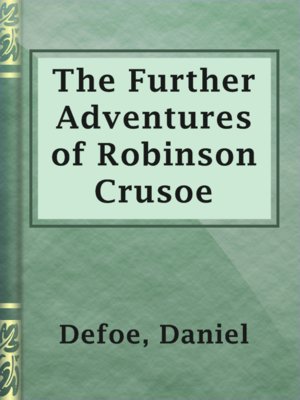 The Further Adventures of Robinson Crusoe by ISBN: 9781535420952Having returned safely home, Crusoe marries and starts a family. But despite his prosperous life, he finds nothing to challenge him and suffers from a burning desire to return to sea. Although his wife begs him not to go, Crusoe and his man Friday set sail. When they reach the island, they are surprised to find that things have changed dramatically. When Crusoe and Friday set out for the mainland, they are attacked by vicious cannibals and Friday is killed. Overwhelmed with grief for the loss of his faithful servant and friend, Crusoe embarks on a long voyage around the world. His travels take him to far-flung places from Brazil and Madagascar to Siberia and China. As he continues to journey, it becomes clear that he is happiest when wandering, and we begin to wonder if he will ever return home again.
The Further Adventures of Robinson Crusoe by ISBN: 9781535420952Having returned safely home, Crusoe marries and starts a family. But despite his prosperous life, he finds nothing to challenge him and suffers from a burning desire to return to sea. Although his wife begs him not to go, Crusoe and his man Friday set sail. When they reach the island, they are surprised to find that things have changed dramatically. When Crusoe and Friday set out for the mainland, they are attacked by vicious cannibals and Friday is killed. Overwhelmed with grief for the loss of his faithful servant and friend, Crusoe embarks on a long voyage around the world. His travels take him to far-flung places from Brazil and Madagascar to Siberia and China. As he continues to journey, it becomes clear that he is happiest when wandering, and we begin to wonder if he will ever return home again.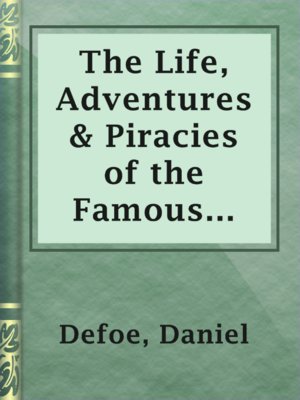 The Life, Adventures, and Piracies of the Famous Captain Singleton by ISBN: 9781402197369
The Life, Adventures, and Piracies of the Famous Captain Singleton by ISBN: 9781402197369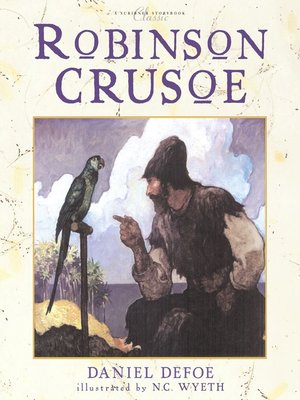 Robinson Crusoe by ISBN: 9780141393407'I walk'd about on the shore, lifting up my hands, and my whole being, as I may say, wrapt up in the contemplation of my deliverance ... reflecting upon all my comrades that were drown'd, and that there should not be one soul sav'd but my self ... ' Who has not dreamed of life on an exotic isle, far away from civilization? Here is the novel which has inspired countless imitations by lesser writers, none of which equal the power and originality of Defoe's famous book. Robinson Crusoe, set ashore on an island after a terrible storm at sea, is forced to make do with only a knife, some tobacco, and a pipe. He learns how to build a canoe, make bread, and endure endless solitude. That is, until, twenty-four years later, when he confronts another human being.
Robinson Crusoe by ISBN: 9780141393407'I walk'd about on the shore, lifting up my hands, and my whole being, as I may say, wrapt up in the contemplation of my deliverance ... reflecting upon all my comrades that were drown'd, and that there should not be one soul sav'd but my self ... ' Who has not dreamed of life on an exotic isle, far away from civilization? Here is the novel which has inspired countless imitations by lesser writers, none of which equal the power and originality of Defoe's famous book. Robinson Crusoe, set ashore on an island after a terrible storm at sea, is forced to make do with only a knife, some tobacco, and a pipe. He learns how to build a canoe, make bread, and endure endless solitude. That is, until, twenty-four years later, when he confronts another human being.A Child's History of England by
ISBN: 9781847188786Dickens's self-imposed task in A Child's History of England makes it particularly revealing of his attitudes to history, morality (personal and social), children and education.A Christmas Carol by
ISBN: 9781503212831Publication Date: 2014-11-28A Christmas Carol is a novella by English author Charles Dickens. It was first published by Chapman & Hall on 19 December 1843. Carol tells the story of a bitter old miser named Ebenezer Scrooge and his transformation resulting from a supernatural visit by the ghost of his former business partner Jacob Marley and the Ghosts of Christmases Past, Present and Yet to Come. The novella met with instant success and critical acclaim.The book was written and published in early Victorian era Britain, a period when there was strong nostalgia for old Christmas traditions together with the introduction of new customs, such as Christmas trees and greeting cards. Dickens' sources for the tale appear to be many and varied, but are, principally, the humiliating experiences of his childhood, his sympathy for the poor, and various Christmas stories and fairy talesThe Cricket on the Hearth (Esprios Classics) by
ISBN: 9781714961443Publication Date: 2020-07-22The Cricket on the Hearth: A Fairy Tale of Home is a novella by Charles Dickens, published in 1845. Like all of Dickens's Christmas books, it was published in book form, not as a serial. Dickens described the novel as "quiet and domestic [...] innocent and pretty." It is subdivided into chapters called "Chirps", similar to the "Quarters" of The Chimes or the "Staves" of A Christmas Carol. It is the third of Dickens's five Christmas books, preceded by A Christmas Carol (1843) and The Chimes (1844), and followed by The Battle of Life (1846) and The Haunted Man and the Ghost's Bargain (1848).David Copperfield by
ISBN: 9783829053853One of Dickens's best-loved and most personal novels, David Copperfield is the embodiment of Dickens's own boyhood experience recalling his employment as a child in a London warehouse. This edition, which has the accurate Clarendon text, includes Dickens's trial titles and working notes, andeight original illustrations by "Phiz."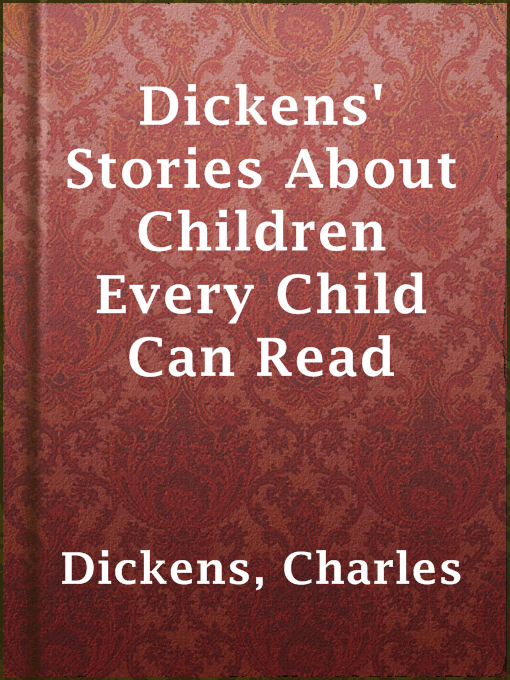 Dickens' Stories about Children That Every Child Can Read by ISBN: 9781456355913To the Young Reader:Charles Dickens was one of the greatest among the many story-writers of "the Victorian age;" that is, the middle and latter part of the Nineteenth Century, when Victoria was Queen of Great Britain. Perhaps he was the greatest of them all for now, a generation after he passed away, more people read the stories of Dickens than those by any other author of that period. In those wonderful writ-ings are found many pictures of child-life connected with the plan of the novels or stories. These child-stories have been taken out of their connections and are told by themselves in this volume. By and by you will read for yourselves, "The Christmas Carol," "The Chimes," "David Copperfield," "The Old Curiosity Shop," and the other great books by that fascinating writer, who saw people whom no-body else ever saw, and made them real. When you read those books you will meet again these charming children, and will remember them as the friends of your childhood.Jesse L. Hurlbut
Dickens' Stories about Children That Every Child Can Read by ISBN: 9781456355913To the Young Reader:Charles Dickens was one of the greatest among the many story-writers of "the Victorian age;" that is, the middle and latter part of the Nineteenth Century, when Victoria was Queen of Great Britain. Perhaps he was the greatest of them all for now, a generation after he passed away, more people read the stories of Dickens than those by any other author of that period. In those wonderful writ-ings are found many pictures of child-life connected with the plan of the novels or stories. These child-stories have been taken out of their connections and are told by themselves in this volume. By and by you will read for yourselves, "The Christmas Carol," "The Chimes," "David Copperfield," "The Old Curiosity Shop," and the other great books by that fascinating writer, who saw people whom no-body else ever saw, and made them real. When you read those books you will meet again these charming children, and will remember them as the friends of your childhood.Jesse L. HurlbutGreat Expectations by
ISBN: 9781503275188Great Expectations is Charles Dickens's thirteenth novel. It is his second novel, after David Copperfield, to be fully narrated in the first person. Great Expectations is a bildungsroman, or a coming-of-age novel, and it is a classic work of Victorian literature. It depicts the growth and personal development of an orphan named Pip. The novel was first published in serial form in Dickens's weekly periodical All the Year Round, from 1 December 1860 to August 1861. In October 1861, Chapman and Hall published the novel in three volumes.Dickens originally intended Great Expectations to be twice as long, but constraints imposed by the management of All the Year Round limited the novel's length. The novel is collected and dense, with a conciseness unusual for Dickens. According to G. K. Chesterton, Dickens penned Great Expectations in "the afternoon of [his] life and fame." It was the penultimate novel Dickens completed, preceding Our Mutual Friend.It is set among the marshes of Kent and in London in the early to mid-1800s. The novel contains some of Dickens most memorable scenes, including its opening, in a graveyard, when the young orphan Pip is accosted by the escaped convict, Abel Magwitch. Great Expectations is a graphic book, full of extreme imagery, poverty, prison ships ("the hulks"), barriers and chains, and fights to the death.Upon its release, Thomas Carlyle spoke of "All that Pip's nonsense." Later, George Bernard Shaw praised the novel as "All of one piece and consistently truthfull." Dickens felt Great Expectations was his best work, calling it "a very fine idea," and was very sensitive to compliments from his friends: "Bulwer, who has been, as I think you know, extraordinarily taken by the book."Great Expectations has a colourful cast that has entered popular culture: the capricious Miss Havisham, the cold and beautiful Estella, Joe the kind and generous blacksmith, the dry and sycophantic Uncle Pumblechook, Mr. Jaggers, Wemmick with his dual personality, and the eloquent and wise friend, Herbert Pocket. Throughout the narrative, typical Dickensian themes emerge: wealth and poverty, love and rejection, and the eventual triumph of good over evil. Great Expectations has become very popular and is now taught as a classic in many English classes. It has been translated into many languages and adapted many times in film and other media.The Mystery of Edwin Drood by
ISBN: 9780140439267'Dickens's finest work in the genre of the detective story was his last' The Times Edwin Drood is contracted to marry orphan Rosa when he comes of age, but when they find that duty has gradually replaced affection, they agree to break off the engagement. Shortly afterwards, in the middle of a storm on Christmas Eve, Edwin disappears. Beyond this there are further intrigues: the dark opium underworld of the sleepy cathedral town of Cloisterham, and the sinister double life of choir-master Jasper, whose drug-fuelled fantasy life belies his appearance. Dickens died before completing Edwin Drood, leaving generations of readers to try and solve its tantalizing mystery. Edited with an Introduction and Notes by David ParoissienNicholas Nickleby by
ISBN: 9780199538225Our hero confronts a large and varied cast, including Wackford Squeers, the fantastic ogre of a schoolmaster, and Vincent Crummles, the grandiloquent ham actor, on his comic and satirical adventures up and down the country. Punishing wickedness, befriending the helpless, strutting the stage,and falling in love, Nicholas shares some of his creator's energy and earnestness as he faces the pressing issues of early Victorian society.Oliver Twist by
ISBN: 9780141439747The story of the orphan Oliver, who runs away from the workhouse only to be taken in by a den of thieves, shocked readers when it was first published. Dickens's tale of childhood innocence beset by evil depicts the dark criminal underworld of a London peopled by vivid and memorable characters - the arch-villain Fagin, the artful Dodger, the menacing Bill Sikes and the prostitute Nancy. Combining elements of Gothic Romance, the Newgate Novel and popular melodrama, in Oliver TwistDickens created an entirely new kind of fiction, scathing in its indictment of a cruel society, and pervaded by an unforgettable sense of threat and mystery.This is the first critical edition to use the Bentley's Miscellanyserial text of 1837-9, showing Oliver Twistas it appeared to its earliest readers. It includes Dickens's 1841 introduction and 1850 preface, the original illustrations and a glossary of contemporary slang.The Pickwick Papers by
ISBN: 9780140436112'One of my life's greatest tragedies is to have already read Pickwick Papers - I can't go back and read it for the first time' Fernando Pessoa Few first novels have created as much popular excitement as The Pickwick Papers - a comic masterpiece that catapulted its twenty-four-year-old author to immediate fame. Readers were captivated by the adventures of the poet Snodgrass, the sportsman Winkle and, above all, by that quintessentially English Quixote, Mr Pickwick, and his cockney Sancho Panza, Sam Weller. From the hallowed turf of Dingley Dell Cricket Club to the unholy fracas of the Eatanswill election, characters and incidents sprang to life from Dickens's pen, to form an enduringly popular work of ebullient humour and literary invention. Edited with an Introduction and Notes by Mark WormaldSome Christmas Stories (Annotated) by
ISBN: 9781532901768A collection of short Christmas stories and inspiring tales by Charles Dickens. ContentsA Christmas tree -- What Christmas is as we grow older -- The poor relation's story -- The child's story -- The schoolboy's story -- Nobody's story.A Tale of Two Cities by
ISBN: 9780486406510Against the backdrop of the French Revolution, Dickens unfolds a masterpiece of drama, adventure, and courage featuring Charles Darnay, a man falsely accused of treason. He bears an uncanny resemblance to the dissolute, yet noble Sydney Carton. Brilliantly plotted, the novel culminates in a daring prison escape in the shadow of the guillotine.The Karamazov Brothers by
ISBN: 9780192835093Dostoevsky's last and greatest novel, The Karamazov Brothers (1880) is both a brilliantly told crime story and a passionate philosophical debate. The dissolute landowner Fyodor Pavlovich Karamazov is murdered; his sons - the atheist intellectual Ivan, the hot-blooded Dmitry, and the saintlynovice Alyosha - are all at some level involved.Bound up with this intense family drama is Dostoevsky's exploration of many deeply felt ideas about the existence of God, the question of human freedom, the collective nature of guilt, the disatrous consequences of rationalism. The novel is also richly comic: the Russian Orthodox Church, the legalsystem, and even the authors most cherisehd causes and beliefs are presented with a note of irreverence, so that orthodoxy, and radicalism, sanity and madness, love and hatred, right and wrong are no longer mutually exclusive. Rebecca West considered it "the allegory for the world's maturity", butwith children to the fore. This new translation does full justice to Doestoevsky's genius, particularly in the use of the spoken word, which ranges over every mode of human expression.Notes from Underground by
ISBN: 9780679734529Dostoevsky's most revolutionary novel, Notes from Underground marks the dividing line between nineteenth- and twentieth-century fiction, and between the visions of self each century embodied. One of the most remarkable characters in literature, the unnamed narrator is a former official who has defiantly withdrawn into an underground existence. In full retreat from society, he scrawls a passionate, obsessive, self-contradictory narrative that serves as a devastating attack on social utopianism and an assertion of man's essentially irrational nature.
Silas Marner by
ISBN: 9780451530622Publication Date: 2007-08-07The classic novel of hope, redemption, and the indomitable human spirit, from beloved novelist George Eliot. In this heartwarming classic by George Eliot, a gentle linen weaver named Silas Marner is wrongly accused of a heinous theft actually committed by his best friend. Exiling himself to the rustic village of Raveloe, he becomes a lonely recluse. Ultimately, Marner finds redemption and spiritual rebirth through his unselfish love for an abandoned child who mysteriously appears one day in his isolated cottage. Somber, yet hopeful, Eliot's realistic depiction of an irretrievable past, tempered with the magical elements of myth and fairy tale, remains timeless in its understanding of human nature and has been beloved for generations. With an Introduction by Frederick R. Karl and an Afterword by Kathryn Hughes
Moonfleet by
ISBN: 9781603863070Fairies and Folk of Ireland by
ISBN: 9781497460416Publication Date: 2014-03-27Wm Frost uses well known mythical and ghost stories of ancient Ireland to illustrate his own fairy tale about two Irish families who immigrate to America - along with the Fairies who lived near them - near the turn of the century (1900). (from Michael on Goodreads.com)
Dream Days by
ISBN: 9781406833447The Original Folk and Fairy Tales of the Brothers Grimm by
ISBN: 9780691160597Publication Date: 2014-10-19
The Mayor of Casterbridge by
ISBN: 9780140431254Tess of the D'Urbervilles by
ISBN: 9780140435146Publication Date: 1999-01-01Tess is driven by her poverty into the service of her wealthy relations. Her lowly position leads her to become the victim of her cousin, Alec, her seducer and nemesis. When she marries Angel Clare, she confesses her past, but Clare is unforgiving and cruelly leaves her to face her destiny alone.Nights with Uncle Remus by
ISBN: 9780142437667Nights with Uncle Remus gathers seventy-one of Joel Chandler Harris's most popular stories of the Antebellum South, including the classic trickster tales of Brer rabbit, creation myths, Sea Island legends, chilling ghost stories, and the indispensable 'The Moon in the Mill-Pond.' Told through the distinctive voices of four slave storytellers, these anthropomorphic tales have not only created cultural icons like the 'Tar baby,' but have inspired writers from Mark Twain to William Faulkner, Zora Neale Hurston to Toni Morrison, and helped revolutionize modern children's literature and folktale collecting.The House of the Seven Gables by
ISBN: 9780140390056This enduring novel of crime and retribution vividly reflects the social and moral values of New England in the 1840s. Nathaniel Hawthorne's gripping psychological drama concerns the Pyncheon family, a dynasty founded on pious theft, who live for generations under a dead man's curse until their house is finally exorcised by love. Hawthorne, by birth and education, was instilled with the Puritan belief in America's limitless promise. Yet - in part because of blemishes on his own family history - he also saw the darker side of the young nation. Like his twentieth-century heirs William Faulkner and F. Scott Fitzgerald, Hawthorne peered behind propriety's façade and exposed the true human condition.Passages from the American Notebooks by
ISBN: 9780554318424Salem June 15 1835.-A walk down to the Juniper. The shore of the coves strewn with bunches of sea-weed driven in by recent winds. Eel-grass rolled and bundled up and entangled with it -large marine vegetables of an olive-color with round slender snake-like stalks four or five feet long and nearly two feet broad: these are the herbage of the deep sea.Passages from the American Notebooks by
ISBN: 9781426425707The Scarlet Letter by
ISBN: 9781512090567Tanglewood Tales by
ISBN: 9781606600269One of 19th-century America's greatest authors recounts timeless tales from Greek mythology.Twice-Told Tales by
ISBN: 9780375757884This volume of short stories and shorter works by Nathaniel Hawthorne was heralded upon its release and is still widely considered a classic.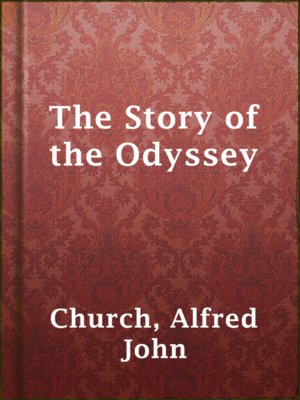 The Odyssey by ISBN: 9780140268867
The Odyssey by ISBN: 9780140268867The Bobbsey Twins at School by
ISBN: 9781406501247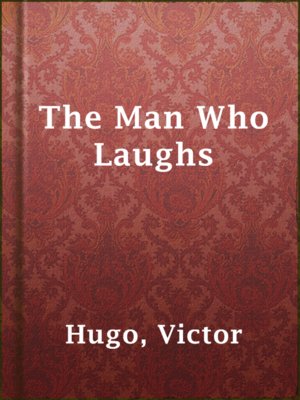 The Man Who Laughs by ISBN: 9781466269071
The Man Who Laughs by ISBN: 9781466269071Notre-Dame of Paris by
ISBN: 9780140443530More commonly known as The Hunchback of Notre-Dame, Victor Hugo's Romantic novel of dark passions and unrequited love. In the vaulted Gothic towers of Notre-Dame Cathedral lives Quasimodo, the hunchbacked bellringer. Mocked and shunned for his appearance, he is pitied only by Esmerelda, a beautiful gypsy dancer to whom he becomes completely devoted. Esmerelda, however, has also attracted the attention of the sinister archdeacon Claude Frollo, and when she rejects his lecherous approaches, Frollo hatches a plot to destroy her, that only Quasimodo can prevent. Victor Hugo's sensational, evocative novel brings life to the medieval Paris he loved, and mourns its passing in one of the greatest historical romances of the nineteenth century.
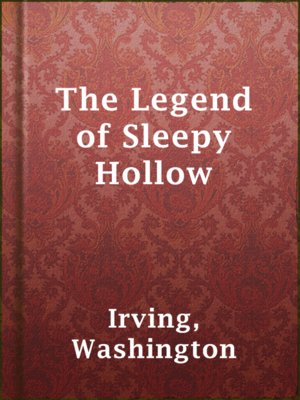 The Legend of Sleepy Hollow by ISBN: 9781530176519Publication Date: 2016-02-21The Legend Of Sleepy Hollow by Washington Irving is an eerie tale set deep in the forest. This is a classic story and one which has inspired a recent motion picture and also one which has been enthralling people for generations.
The Legend of Sleepy Hollow by ISBN: 9781530176519Publication Date: 2016-02-21The Legend Of Sleepy Hollow by Washington Irving is an eerie tale set deep in the forest. This is a classic story and one which has inspired a recent motion picture and also one which has been enthralling people for generations.
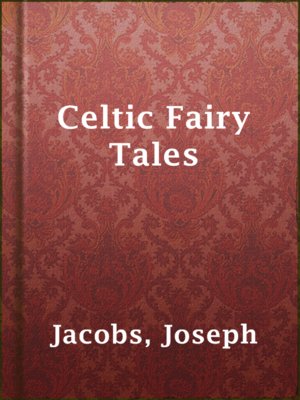 Celtic Fairy Tales by ISBN: 9781421819839Connla of the Fiery Hair was son of Conn of the Hundred Fights. One day as he stood by the side of his father on the height of Usna, he saw a maiden clad in strange attire coming towards him. Whence comest thou, maiden? said Connla. I come from the Plains of the Ever Living, she said, there where there is neither death nor sin.
Celtic Fairy Tales by ISBN: 9781421819839Connla of the Fiery Hair was son of Conn of the Hundred Fights. One day as he stood by the side of his father on the height of Usna, he saw a maiden clad in strange attire coming towards him. Whence comest thou, maiden? said Connla. I come from the Plains of the Ever Living, she said, there where there is neither death nor sin.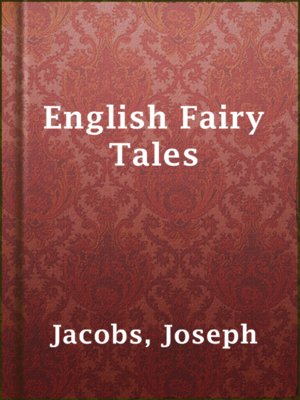 English Fairy Tales by ISBN: 9780679428091
English Fairy Tales by ISBN: 9780679428091Indian Fairy Tales by
ISBN: 9781877527395Soils and national characters differ; but fairy tales are the same in plot and incidents, if not in treatment. The majority of the tales in this volume have been known in the West in some form or other, and the problem arises how to account for their simultaneous existence in farthest West and East. Some - as Benfey in Germany, M. Cosquin in France, and Mr. Clouston in England - have declared that India is the Home of the Fairy Tale, and that all European fairy tales have been brought...The Lesson of the Master by
ISBN: 9781717045263 The Patagonia by ISBN: 9781519284068This 1891 novelette by Henry James tells of an ocean voyage on a ship called The Patagonia, sailing from Boston to Liverpool. The unnamed narrator is friends with a Mrs. Nettlepoint, a woman of good family with a son names Jason. Accompanying them -- somewhat unexpectedly -- is a young woman named Grace Mavis, who is to marry a childhood friend whom she has not seen for ten years. During the cruise, it appears that Miss Mavis is spending an inordinate amount of time with Jason Nettlepoint, who is some years younger than she is. The usual shipboard gossip has decided that Grace and Jason are an "item," and that the woman's intended would likely be thrown over. There is something of a surprise ending which abashes the characters circling around Grace Mavis worrying about the proprieties.
The Patagonia by ISBN: 9781519284068This 1891 novelette by Henry James tells of an ocean voyage on a ship called The Patagonia, sailing from Boston to Liverpool. The unnamed narrator is friends with a Mrs. Nettlepoint, a woman of good family with a son names Jason. Accompanying them -- somewhat unexpectedly -- is a young woman named Grace Mavis, who is to marry a childhood friend whom she has not seen for ten years. During the cruise, it appears that Miss Mavis is spending an inordinate amount of time with Jason Nettlepoint, who is some years younger than she is. The usual shipboard gossip has decided that Grace and Jason are an "item," and that the woman's intended would likely be thrown over. There is something of a surprise ending which abashes the characters circling around Grace Mavis worrying about the proprieties.The Reverberator by
ISBN: 9781612191560A quintessential Henry James classic is finally given the attention it deserves. It's unclear why more Henry James fans aren't familiar with this wicked early work, as it's James at his scathing best - piercing, elegant and ahead of his time. The story of an American hack journalist in Europe, The Reverberator is an early example of James' fascination with Americans confronting Europe's version of civilised society. Yet here he gives the theme a sly twist, as the Europeans find themselves enamoured with a particularly uncivil brand of Americanism.The Turn of the Screw by
ISBN: 9781612930992A Portrait of the Artist As a Young Man by
ISBN: 9780486280509Masterpiece of semi-autobiographical fiction reveals a powerful portrait of the coming of age of a young man of unusual intelligence, sensitivity, and character.
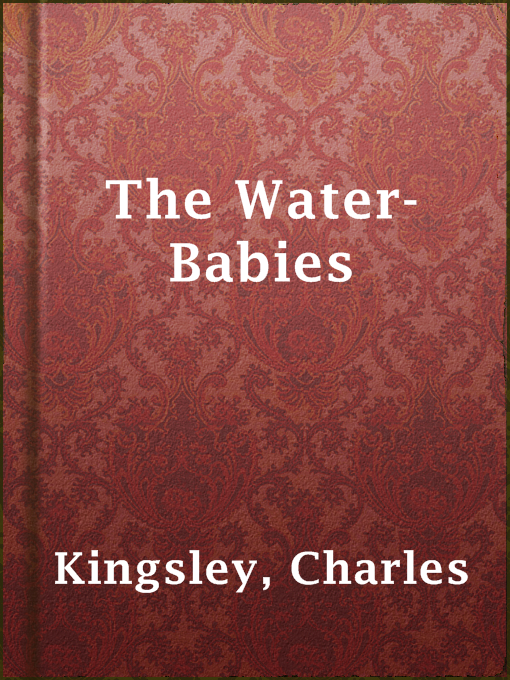 The Water Babies by ISBN: 9781853261480Tom, a poor orphan, is employed by the villainous chimney-sweep, Grimes, to climb up inside flues to clear away the soot. While engaged in this dreadful task, he loses his way and emerges in the bedroom of Ellie, the young daughter of the house who mistakes him for a thief. He runs away, and, hot and bothered, he slips into a cooling stream, falls asleep, and becomes a Water Baby. In his new life, he meets all sorts of aquatic creatures, including an engaging old lobster, other water babies, and at last reaches St Branden's Isle where he encounters the fierce Mrs Bedonebyeasyoudid and the motherly Mrs Doasyouwouldbedoneby. After a long and arduous quest to the Other-end-of-Nowhere young Tom achieves his heart's desire.
The Water Babies by ISBN: 9781853261480Tom, a poor orphan, is employed by the villainous chimney-sweep, Grimes, to climb up inside flues to clear away the soot. While engaged in this dreadful task, he loses his way and emerges in the bedroom of Ellie, the young daughter of the house who mistakes him for a thief. He runs away, and, hot and bothered, he slips into a cooling stream, falls asleep, and becomes a Water Baby. In his new life, he meets all sorts of aquatic creatures, including an engaging old lobster, other water babies, and at last reaches St Branden's Isle where he encounters the fierce Mrs Bedonebyeasyoudid and the motherly Mrs Doasyouwouldbedoneby. After a long and arduous quest to the Other-end-of-Nowhere young Tom achieves his heart's desire.Captains Courageous by
ISBN: 9780486407869A pampered millionaire's son tumbles overboard from a luxury liner and falls into good fortune, disguised in the form of a fishing boat. The gruff and hearty crew teach the young man to be worth his salt as they fish the waters off the Grand Banks of Newfoundland. Brimming with adventure and humor.The Jungle Book by
ISBN: 9781503332546The Jungle Book (1894) is a collection of stories by English author Rudyard Kipling. The tales in the book are fables, using animals in an anthropomorphic manner to give moral lessons. Just So Stories by ISBN: 9781493679102Once upon a time, O my Best Beloved . . . So begins this classic collection of gloriously fanciful tales of how things in the world came to be as they are. This collection includes the story of how the lazy camel found himself with a hump and how the insatiable curiosity of the elephant earned him his long trunk. It reveals how the whale was given a throat, and why every rhinoceros has great folds in his skin and a very bad temper. We also find out about the cunning cat that walked by itself, and how clever little Taffy and her Daddy Tegumai made the first alphabet.
Just So Stories by ISBN: 9781493679102Once upon a time, O my Best Beloved . . . So begins this classic collection of gloriously fanciful tales of how things in the world came to be as they are. This collection includes the story of how the lazy camel found himself with a hump and how the insatiable curiosity of the elephant earned him his long trunk. It reveals how the whale was given a throat, and why every rhinoceros has great folds in his skin and a very bad temper. We also find out about the cunning cat that walked by itself, and how clever little Taffy and her Daddy Tegumai made the first alphabet.The Man Who Would Be King by
ISBN: 97814068191375 tales, including 'The Man Who Would Be King' and 'My Own True Ghost Story'The Phantom Rickshaw and Other Ghost Stories by
ISBN: 9781679787010Puck of Pook's Hill by
ISBN: 9780755117338Enchanted by the theatre, Dan and Una decide to recreate their own version of A Midsummer Night's Dream. Finding the perfect spot, an old fairy ring, they set about their play, and are so enchanted that they perform it three times in a row. After a final bow, they sit down in the centre of the fairy ring - whereupon, the bushes part and Puck enters, stage left. Using his fairy magic, Puck then conjures up the past to entertain the two amazed children - a Roman centurion, a Renaissance artisan and a bygone village all appear before their very eyes. Puck of Pook's Hill is an innocent and charming tale to delight readers of all ages.The Second Jungle Book(1895),by Rudyard Kipling (Children's Classics) by
ISBN: 9781534798786The Second Jungle Book is a sequel to The Jungle Book by Rudyard Kipling. First published in 1895, it features five stories about Mowgli and three unrelated stories, all but one set in India, most of which Kipling wrote while living in Vermont.
Tales from Shakespeare by
ISBN: 9781853261404Tales from Shakespeare by Charles and Mary Lamb was written to be an 'introduction to the study of Shakespeare', but are much more entertaining than that. All of Shakespeare's best-loved plays, comic and tragic, are retold in a clear and robust style, and their literary quality has made them popular and sought-after ever since their first publication in 1807. This edition contains the delightful pen-and-ink drawings of Arthur Rackham.The Blue Fairy Book by
ISBN: 9780486214375Publication Date: 1965-06-01Finest stories from around the world -- most of them old favorites: "Sleeping Beauty," "Rumpelstiltskin," "Cinderella," "The Arabian Nights," 33 more.The Brown Fairy Book by
ISBN: 9780486214382Publication Date: 1965-06-0132 less familiar folk tales from the American Indians, Australian Bushmen, African Kaffirs, and from Persia, Lapland, Brazil, and India. Different enough to capture all imaginations.The Crimson Fairy Book by
ISBN: 9780486217994Publication Date: 1967-06-01One of England's top folklorists presents another volume in his much-loved "rainbow" series of fairy books. These 36 stories originated in Hungary, Russia, Finland, Iceland, Tunisia, the Baltic, and elsewhere. They include "The Cottager and His Cat," "The Crab and the Monkey," "Little Wildrose," "The Gold-bearded Man," and others.The Green Fairy Book by
ISBN: 9780486214399Publication Date: 1965-06-01Giants, dwarfs, monsters, and magicians star in 42 classic stories from China, Russia, Italy, Spain, France, Germany, Scotland, and England. Includes "The Three Little Pigs" and "The Half-Chick."The Grey Fairy Book by
ISBN: 9780486217918Publication Date: 1967-06-0135 stories, many from oral traditions, others from French, German, Italian collections: "The Goat-faced Girl," "The Sunchild," "The Street Musicians," "The Twin Brothers," "Prunella," and many more.The Lilac Fairy Book by
ISBN: 0486219070Publication Date: 1968-06-0133 tales from Portugal, Ireland, Wales, and points East and West, among them "The Brown Bear of Norway," "The Enchanted Deer," "The Story of a Very Bad Boy," and "The Brownie of the Lake."The Olive Fairy Book by
ISBN: 0800759219087"The Olive Fairy Book," the eleventh in Andrew Lang's "Coloured" Fairy Book series, was originally published in 1907. The collections were specifically intended for children, and consequently edited for that end. This book contains these stories: Madschun, The Blue Parrot, Geirlaug the King's Daughter, The Story of Little King Loc, 'A Long-bow Story', Jackal or Tiger?, The Comb and the Collar, The Thanksgiving of the Wazir, Samba the Coward, Kupti and Imani, The Strange Adventures of Little Maia, Diamond cut Diamond, The Green Knight, The Five Wise Words of the Guru, The Golden-headed Fish, Dorani, The Satin Surgeon, The Billy Goat and the King, The Story of Zoulvisia, Grasp all, Lose all, The Fate of the Turtle, The Snake Prince, The Prince and Princess in the Forest, The Clever Weaver, The Boy Who Found Fear at Last, He Wins Who Waits, The Steel Cane, The Punishment of the Fairy Gangana, and The Silent Princess.The Orange Fairy Book by
ISBN: 9780486219097Publication Date: 1968-06-01"The Magic Mirror," "The Two Caskets," "The Clever Cat," "The White Slipper," and "The Girl-Fish." 33 tales from Jutland, Rhodesia, Uganda, and various European traditions.The Pink Fairy Book by
ISBN: 9780486217925Publication Date: 1967-06-01Forty-one Japanese, Scandinavian, and Sicilian tales: "The Snow-Queen," "The Cunning Shoemaker," "The Two Brothers," "The Merry Wives," "The Man without a Heart," and more. All the stories are narrated in the clear, lively prose for which Lang was famous and are considered to be the very best English versions available.The Red Fairy Book by
ISBN: 9780486216737Publication Date: 1966-06-01It is almost impossible to envision what childhood would be like without the enchanting world of fairyland. Three-headed trolls, horses that carry their masters up mountains of glass, giants and dwarfs, monsters and magicians, fairies and ogres -- these are the companions who will thrill young boys and girls of all lands and all times, as Andrew Lang's phenomenally successful collections of stories have proved. From the day that they were first printed, the Lang fairy tale books of many colors have entertained thousands of boys and girls, as they have also brought pleasure to the many parents who have read these unforgettable classics to their children. In addition to such familiar favorites as Jack and the Beanstalk, Rapunzel, The Ratcatcher (The Pied Piper), and Snowdrop (Snow White), The Red Fairy Book contains a wonderful collection of lesser-known tales from French, German, Danish, Russian, and Romanian sources. A tale from Norse mythology recounts the old story of Sigurd and Brynhild; tales by the great Madame d'Aulnoy include Graciosa and Percinet and Princess Rosette; lesser-known tales from Grimm's collection include The Three Dwarfs, Mother Holle, and The Golden Goose. All in all, this collection contains 37 stories, all narrated in the clear, lively prose for which Lang was famous. Not only are Lang's generally conceded to be the best English versions of standard stories, his collections are the richest and widest in range. His position as one of England's foremost folklorists as well as his first-rate literary abilities makes his collections unmatchable in the English language.The Violet Fairy Book by
ISBN: 9780486216751Publication Date: 1966-06-01Roumania, Japan, Serbia, Lithuania, Africa, Portugal, and Russia are among the sources of these 35 stories that tell of a haunted forest, chests of gold coins, a magical dog, and a man who outwits a dragon.The Yellow Fairy Book by
ISBN: 9780486216744Publication Date: 1966-06-01American Indian, Russian, German, Icelandic, French, and other stories -- 48 in all -- among them "The Tinder-box," "The Nightingale," and "How to Tell a True Princess."A Book of Nonsense by
ISBN: 9780679417989Publication Date: 1992-11-03The owls, hen, larks, and their nests in his beard, are among the fey fauna and peculiar persons inhabiting the uniquely inspired nonsense rhymes and drawings of Lear (20th child of a London stockbroker), whose Book of Nonsense, first published in 1846, stands alone as the ultimate and most loved expression in English of freewheeling, benign, and unconstricted merriment.Phantom of the Opera by
ISBN: 9780060809249The novel that inspired the Lon Chaney film and the hit musical. "The wildest and most fantastic of tales."--New York Times Book Review.A Daughter of the Snows by
ISBN: 9781948132213Jack London books by SeaWolf Press were selected for sale by the Jack London Museum. A beautfiul version with the first edition cover and original illustrations. This edition is part of the 100th Anniversary Collection honoring the 100th anniversary of Jack London's death in 1916. In his short 20-year career, he produced more than 50 books. The text and illustrations in this collection are taken from his early publications and the covers are replicas of the first edition covers. Fonts common 100 years ago are used--Century for the text and Bembo on the cover. The book's original format is matched as much as possible. Jack London's first novel (his earlier books were collections of short stories), A Daughter of the Snows follows the adventurous heroine, Frona Welse, as she returns to Alaska from school at Stanford. She travels to the Klondike gold rush dealing with the men of the North as an equal. She falls in love with two men and narrowly escapes death in a frozen river.Jerry of the Islands by
ISBN: 9781548429065Jerry of the Islands: A True Dog Story was initially published in 1917 and is one of the last works by Jack London. The novel is set on the island of Malaita, a part of the Solomon Islands archipelago, which in 1893 became a British protectorate. The hero of the novel is Irish terrier Jerry.The Little Lady of the Big House by
ISBN: 9781948132664Jack London books by SeaWolf Press were selected for sale by the Jack London Museum. A beautfiul version with the first edition cover and original illustration. This edition is part of the 100th Anniversary Collection honoring the 100th anniversary of Jack London's death in 1916. The last of London's books published during his lifetime, it involves a love triangle set in California. The main character, Paula, is married to Dick Forrest but falls in love with Evan Graham. The story's sexuality bothered readers at the time but their actions appear rather unrealistic based on modern day standards.Scarlet Plague by
ISBN: 9781453712382Jack London's post-apocalyptic vision takes place in 2072, sixty years after an uncontrollable plague epidemic has depopulated the planet. James Howard Smith, one of the few survivalists left alive in the San Francisco area, tries to impart the value of wisdom of a world left behind to his grandsons as his time on Earth grows ever shorter.A SON of the SUN by JACK LONDON by
ISBN: 9781503044906The Song of Hiawatha by
ISBN: 9780486447957The infectious rhythm of The Song of Hiawatha has drawn millions to the shores of Gitchee Gumee. Once there, they've stayed to hear about the young brave with the magic moccasins, who talks with animals and uses his supernatural gifts to bring peace and enlightenment to his people. This 1855 masterpiece combines romance and idealism in an idyllic natural setting.Concerning Christian Liberty by
ISBN: 1162658274Among those monstrous evils of this age with which I have now for three years been waging war, I am sometimes compelled to look to you and to call you to mind, most blessed father Leo. In truth, since you alone are everywhere considered as being the cause of my engaging in war, I cannot at any time fail to remember you; and although I have been compelled by the causeless raging of your impious flatterers against me to appeal from your seat to a future council--fearless of the futile decrees of your predecessors Pius and Julius, who in their foolish tyranny prohibited such an action--yet I have never been so alienated in feeling from your Blessedness as not to have sought with all my might, in diligent prayer and crying to God, all the best gifts for you and for your see.
The Children of the New Forest by
ISBN: 1500490040The circumstances which I am about to relate to my juvenile readers took place in the year 1647. By referring to the history of England, of that date, they will find that King Charles the First, against whom the Commons of England had rebelled, after a civil war of nearly five years, had been defeated, and was confined as a prisoner at Hampton Court. The Cavaliers, or the party who fought for King Charles, had all been dispersed and the Parliamentary army under the command of Cromwell were beginning to control the Commons.Moby Dick, or, the White Whale by
ISBN: 9781146375733Publication Date: 2010-03-01This is a reproduction of a book published before 1923. This book may have occasional imperfections such as missing or blurred pages, poor pictures, errant marks, etc. that were either part of the original artifact, or were introduced by the scanning process. We believe this work is culturally important, and despite the imperfections, have elected to bring it back into print as part of our continuing commitment to the preservation of printed works worldwide. We appreciate your understanding of the imperfections in the preservation process, and hope you enjoy this valuable book.Anne of Avonlea by
ISBN: 9781770497337Publication Date: 2014-09-09nbsp;In the years since she arrived at Green Gables, Anne has earned the love and respect of the people of Avonlea--as well as a reputation for getting herself into predicaments. Now sixteen years old--and bound and determined to look after Marilla in the wake of Matthew's death--she's about to begin her job as the town's new schoolteacher. Soon enough she is the one learning lessons, however, as she starts to realize how complicated life can be. In her usual well-intentioned but meddlesome way, Anne is quickly interfering in a new friend's thwarted romance, coping with two new orphans at Green Gables, and getting drawn into the lives of her mostly charming and occasionally exasperating students at Avonlea school. nbsp;nbsp;nbsp;nbsp; The once awkward, freckle-faced little girl is now a mature and responsible young woman, but Anne's imaginative spirit is as strong as ever in this sequel to the much-loved Anne of Green Gables.
Good Stories for Great Holidays by
ISBN: 9781406836097Arranged for story-telling, reading aloud and for the children's own reading
 Maid Marian by ISBN: 9781533096715Maid Marian by Thomas Love Peacock is his fourth long work of fiction first published in 1822. This is a classic that has been enjoyed by many for generations.
Maid Marian by ISBN: 9781533096715Maid Marian by Thomas Love Peacock is his fourth long work of fiction first published in 1822. This is a classic that has been enjoyed by many for generations.The Irish Twins (with the Original Illustrations Start Classics) by
ISBN: 9781627937788Publication Date: 2013-11-01Lucy Fitch Perkins (1865-1937) was an American children's book author and illustrator, famous for writing the "Twins" series of books. She wrote books giving pictures of child life in other countries, and then, for the benefit of American and foreign born children alike, she also wrote books which gave some idea of what had been done for this country by those who had founded and developed it.The Raven by
ISBN: 9781559211789once upon a midnight dreary, while I pondered, weak and weary... thus begins perhaps the most-quoted poem ever written in the English Language. Edgar Allan Poe's The Raven is illustrated with Alen James Robinson's masterful etchings and wood engravings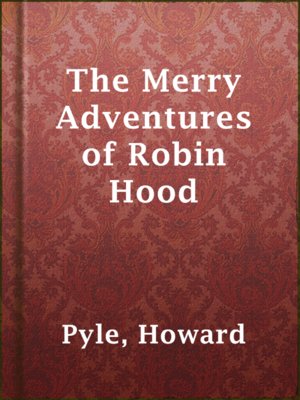 The Merry Adventures of Robin Hood by ISBN: 9780866119641Recounts the legend of Robin Hood, who plundered the king's purse and poached his deer and whose generosity endeared him to the poor.
The Merry Adventures of Robin Hood by ISBN: 9780866119641Recounts the legend of Robin Hood, who plundered the king's purse and poached his deer and whose generosity endeared him to the poor.
Chantecler by
ISBN: 9781534956186Chantecler is a verse play in four acts written by Edmond Rostand. The play is notable in that all the characters are farmyard animals including the main protagonist, a chanticleer, or rooster. The play centers on the theme of idealism and spiritual sincerity, as contrasted with cynicism and artificiality. Much of the play satirizes modernist artistic doctrines from Rostand's romanticist perspective.Cyrano de Bergerac by
ISBN: 9780140449686Poet and soldier, brawler and charmer, Cyrano de Bergerac is desperately in love with Roxane, the most beautiful woman in Paris. But there is one very large problem - he has a nose of stupendous size and believes she will never see past it to return his feelings. So when he discovers that the handsome but tongue-tied Christian is also pining for Roxane, generous Cyrano offers to help by writing exquisite declarations of love for the young man to woo her with. Will she ever recognize who she is really falling in love with? Set during the reign of Louis XIII, Rostand's Cyrano de Bergerac(1897) was one of the great theatrical successes of its time and remains as popular today for its dramatic power and, above all, for its good-natured, passionate and swashbuckling hero.
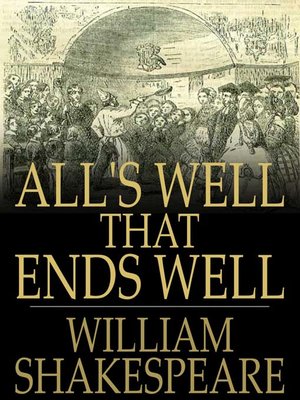 All's Well that Ends Well by ISBN: 9781610426121
All's Well that Ends Well by ISBN: 9781610426121Antony and Cleopatra by
ISBN: 9780553212891A magnificent drama of love and war, this riveting tragedy presents one of Shakespeare's greatest female characters--the seductive, cunning Egyptian queen Cleopatra. The Roman leader Mark Antony, a virtual prisoner of his passion for her, is a man torn between pleasure and virtue, between sensual indolence and duty . . . between an empire and love. Bold, rich, and splendid in its setting and emotions, Antony And Cleopatra ranks among Shakespeare's supreme achievements.As You Like It by
ISBN: 9780743484862Soon after Rosalind and Orlando meet and fall in love, the princesses and Touchstone go into exile in the Forest of Arden, where they find new conversational partners. Duke Frederick, younger brother to Duke Senior, has overthrown his brother and forced him to live homeless in the forest with his courtiers, including the cynical Jaques. Orlando, whose older brother Oliver plotted his death, has fled there, too.The Comedy of Errors by
ISBN: 9781420926231"The Comedy of Errors" is the story of two identical twins named Antipholus who are separated following a shipwreck 25 years earlier. Antipholus of Ephesus grows up in Ephesus with his mother, while Antipholus of Syracuse grows up in Syracuse with his father. Despite a ban on travel between the two cities, their father, Egeon, travels from Syracuse to Ephesus to try and find his long lost son and wife.Hamlet by
ISBN: 9780743477123Hamlet is Shakespeare's most popular, and most puzzling, play. It follows the form of a "revenge tragedy," in which the hero, Hamlet, seeks vengeance against his father's murderer, his uncle Claudius, now the king of Denmark.Julius Caesar by
ISBN: 9780743482745Shakespeare may have written Julius Caesar as the first of his plays to be performed at the Globe, in 1599. For it, he turned to a key event in Roman history: Caesar's death at the hands of friends and fellow politicians. Renaissance writers disagreed over the assassination, seeing Brutus, a leading conspirator, as either hero or villain. Shakespeare's play keeps this debate alive.King Henry V by
ISBN: 9781904271086Henry VIII by
ISBN: 9780743273305In Henry VIII, Shakespeare presents a monarchy in crisis. Noblemen battle with Lord Chancellor Cardinal Wolsey, who taxes the people to the point of rebellion. Witnesses whom Wolsey brings against the Duke of Buckingham claim he is conspiring to take the throne, yet Buckingham seems innocent as he goes to his death. Henry is also without a male heir. After meeting the beautiful Anne Bullen, he says that he suspects his current marriage to Katherine, with whom he has one surviving daughter, is invalid.King John by
ISBN: 9780198129301King Lear by
ISBN: 9780743482769Shakespeare's King Lear challenges us with the magnitude, intensity, and sheer duration of the pain that it represents. Its figures harden their hearts, engage in violence, or try to alleviate the suffering of others. Lear himself rages until his sanity cracks.King Richard II by
ISBN: 9781605974569The play begins with Richard having to pass judgment in a dispute with Henry Bolingbroke and Thomas Mowbray who is being accused of killing Richard's cousin. Richard cannot judge the case, since he had ordered the murder. A tournament between the two men follows. Richard banishes both men from England, which turns out to be his first mistake in a series of errors.Love's Labour's Lost by
ISBN: 9781904271109The Merchant of Venice by
ISBN: 9781932219227Publication Date: 2005-02-03In Shakespeare's most controversial play, the opposing values of justice and mercy must be resolved. Antonio promises money to help his friend Bassanio woo Portia. He borrows the sum needed from the cruel Shylock, but there will be a dreadful penalty if the loan is not repaid. The golden world of Portia's Belmont calls forth some of Shakespeare's most lyrical love poetry. But the dark shadow of Shylock is never far from the heart of this brilliant comedy as it moves toward its courtroom climax.A Midsummer Night's Dream by
ISBN: 9781503250789Publication Date: 2014-11-28A Midsummer Night's Dream is a comedy play by William Shakespeare, believed to have been written between 1590 and 1596. It portrays the events surrounding the marriage of the Duke of Athens, Theseus, and Hippolyta. These include the adventures of four young Athenian lovers and a group of six amateur actors (mechanical), who are controlled and manipulated by the fairies who inhabit the forest in which most of the play is set. The play is one of Shakespeare's most popular works for the stage and is widely performed across the world.Much Ado about Nothing by
ISBN: 9781402794582Shakespeare's sharp comedy about mistaken identities, false suspicions, and a very merry war between the lovers Beatrice and BenedickOthello by
ISBN: 9781417664849Richard III by
ISBN: 9780143130253Romeo and Juliet by
ISBN: 9781497438095Romeo and Juliet is a tragedy written by William Shakespeare early in his career about two young star-crossed lovers whose deaths ultimately reconcile their feuding families.The Merchant of Venice by
ISBN: 9780451526809William Shakespeare's black comedy. A complex play that combines pathos and humor, The Merchant of Venice also introduces one of Shakespeare's most memorable villains, the Jewish moneylender Shylock, who famously demands a "pound of flesh" for what he is owed.Shakespeare's Sonnets by
ISBN: 9780671722876The Taming of the Shrew by
ISBN: 9780743477574Love and marriage are the concerns of Shakespeare's The Taming of the Shrew. Lucentio's marriage to Bianca is prompted by his idealized love of an apparently ideal woman. Petruchio's wooing of Katherine, however, is free of idealism. Petruchio takes money from Bianca's suitors to woo her, since Katherine must marry before her sister by her father's decree; he also arranges the dowry with her father. Petruchio is then ready to marry Katherine, even against her will. Katherine, the shrew of the play's title, certainly acts much changed. But have she and Petruchio learned to love each other? Or is the marriage based on terror and deception?The Tempest by
ISBN: 9780743482837Putting romance onstage, The Tempest gives us a magician, Prospero, a former duke of Milan who was displaced by his treacherous brother, Antonio. Prospero is exiled on an island, where his only companions are his daughter, Miranda, the spirit Ariel, and the monster Caliban. When his enemies are among those caught in a storm near the island, Prospero turns his power upon them through Ariel and other spirits. The characters exceed the roles of villains and heroes. Prospero seems heroic, yet he enslaves Caliban and has an appetite for revenge. Caliban seems to be a monster for attacking Miranda, but appears heroic in resisting Prospero, evoking the period of colonialism during which the play was written. Miranda's engagement to Ferdinand, the Prince of Naples and a member of the shipwrecked party, helps resolve the drama.Twelfth Night by
ISBN: 9780486292908Delightfully comic tale of mistaken identities revolves around the physical likeness between Sebastian and his twin sister Viola, each of whom, when separated after a shipwreck, believes the other to be dead. Filled with superb comedy, this entertaining masterpiece remains one of Shakespeare's most popular and performed comedies.The Two Gentlemen of Verona by
ISBN: 9780671722951While the word "gentlemen" suggests that its heroes are adults, The Two Gentlemen of Verona is more intelligible if we think of them as boys, leaving home for the first time. One has a crush on a girl, Julia, though he hasn't yet told her. Sent to court to learn to be "perfect gentlemen," Valentine and Proteus are derailed by their attraction to Sylvia, the ruler's daughter. Valentine's mental denseness does not deter Sylvia from returning his love, but he is caught, and banished, when he tries to elope with her. Proteus's desire for Sylvia wipes out his former love, leading him into despicable acts that win scorn from Sylvia and wound Julia, who has pursued him disguised as a boy. When Sylvia follows Valentine into banishment, Proteus follows Sylvia, and Julia follows Proteus, the stage is set for a disturbing ending. But the stage is also set for the "gentlemen" to take small steps toward maturity.Frankenstein by
ISBN: 9780486282114Few creatures of horror have seized readers' imaginations and held them for so long as the anguished monster of Mary Shelley's Frankenstein. The story of Victor Frankenstein's terrible creation and the havoc it caused has enthralled generations of readers and inspired countless writers of horror and suspense.Five Little Peppers and How They Grew by
ISBN: 9780486452678Times are tough around the little brown house, but the widowed Mrs. Pepper faces trouble with a stout heart, a smile, and the help of her jolly little Peppers. This heartwarming classic has inspired generations with its tales of the ways in which courage and good cheer can overcome adversity.The Black Arrow by
ISBN: 9780486418209Publication Date: 2001-11-09Set in England during the fifteenth-century Wars of the Roses, this swashbuckling historical novel by the author of Treasure Island and Kidnapped tells the story of young Dick Shelton. Betrayed by his treacherous and brutal guardian, Sir Daniel Brackley, Dick seeks the help of John Amend-All, leader of the mysterious fellowship of the Black Arrow--and Brackley's sworn enemy. Pitted against fierce fighters, a treacherous priest, and Sir Daniel, Dick seeks to become a knight and rescue his true love. Brimming with adventure, suspense, and romance, this thrilling tale presents a classic portrait of England during one of its most tumultuous eras, as Dick is pulled by his loyalties to the houses of both York and Lancaster. He must make a crucial choice, for his fate and the fate of England hang in the balance.Catriona by
ISBN: 9781443768535Robert Louis Stevenson's 1893 novel, "Catriona" is a sequel to his previous novel "Kidnapped," and continues the story of David Balfour.Kidnapped by
ISBN: 9781619491816The young orphan David Balfour is sent to live with his Uncle Ebenezer. When he discovers that he may be the rightful heir to his uncle's estate, he finds himself kidnapped and cast away on a desert isle. A historical adventure novel originally intended for a young-adult audience, "Kidnapped" deals with true historical events relating to the Jacobite Rising, and has won the admiration of an adult audience.The Strange Case of Dr. Jekyll and Mr. Hyde by
ISBN: 9780803292406The Strange Case of Dr. Jekyll and Mr. Hyde is a landmark in psychological fiction. The respectable doctor and his horrifying double are known even to those who have never read Robert Louis Stevenson's short novel.Treasure Island by
ISBN: 9781612930879Dracula by
ISBN: 9781853260865Bram Stoker wrote numerous novels, short stories, essays, and lectures, but Dracula is by far his most famous work. Stoker coined the term undead, and his interpretation of vampire folklore continues to this day to shape the portrayals of legendary monsters.Uncle Tom's Cabin by
ISBN: 9781840224023Uncle Tom's Cabin is the most popular, influential and controversial book written by an American. Stowe's rich, panoramic novel passionately dramatises why the whole of America is implicated in and responsible for the sin of slavery, and resoundingly concludes that only 'repentance, justice and mercy' will prevent the onset of 'the wrath of Almighty God!'. The novel gave such a terrific impetus to the crusade for the abolition of slavery that President Lincoln half-jokingly greeted Stowe as 'the little lady' who started the great Civil War.Freckles by
ISBN: 9780253203632In Freckles a homeless waif finds his deliverance in the primeval Limberlost swamp. Maimed and abandoned as an infant, Freckles seeks a chance to prove his worth. He is given that opportunity as the guard of the precious timber of the Limberlost.A Girl of the Limberlost by
ISBN: 9798673447352A Girl of the Limberlost is considered a classic of Indiana literature. The story takes place in Indiana, in and around the Limberlost Swamp - at that time, a site of heavy logging and natural oil extraction.This Bildungsroman is structured as girl-meets-boy, girl-loses-boy, girl-undertakes-an-adventure-to-win-boy-back.The novel's heroine, Elnora Comstock, is an impoverished young woman who lives with her widowed mother, Katharine Comstock, on the edge of the Limberlost. Elnora faces cold neglect by her mother, a woman who feels ruined by the death of her husband, Robert Comstock, who drowned in quicksand in the swamp. Katharine blames Elnora for his death, because her husband died while she gave birth to their daughter and could not come to his rescue.The Comstocks make money by selling eggs and other farm products, but Mrs. Comstock refuses to cut down a single tree in the forest, or to delve for oil, as the neighbors around them are doing, even though the added income would make their lives easier.Gulliver's Travels by
ISBN: 9780486292731From the preeminent prose satirist in the English language, a great classic recounting the 4 remarkable journeys of ship's surgeon Lemuel Gulliver. For children it remains an enchanting fantasy; for adults, a witty parody of political life in Swift's time and a scathing send-up of manners and morals in 18th-century England.
Adventures of Huckleberry Finn by
ISBN: 9780486280615Climb aboard the raft with Huck and Jim and drift away from the "sivilized" life and into a world of adventure, excitement, danger, and self-discovery. Huck's shrewd and humorous narrative is complemented by lyrical descriptions of the Mississippi valley and a sparkling cast of memorable characters.The Adventures of Tom Sawyer by
ISBN: 9781503215672The Adventures of Tom Sawyer by Mark Twain is an 1876 novel about a young boy growing up along the Mississippi River. The story is set in the fictional town of St. Petersburg, inspired by Hannibal, Missouri, where Twain lived.Tom Sawyer lives with his Aunt Polly and his half-brother Sid. Tom dirties his clothes in a fight and is made to whitewash the fence the next day as punishment. He cleverly persuades his friends to trade him small treasures for the privilege of doing his work. He then trades the treasures for Sunday School tickets which one normally receives for memorizing verses, redeeming them for a Bible, much to the surprise and bewilderment of the superintendent who thought "it was simply preposterous that this boy had warehoused two thousand sheaves of Scriptural wisdom on his premises-a dozen would strain his capacity, without a doubt."Tom falls in love with Becky Thatcher, a new girl in town, and persuades her to get "engaged" by kissing him. But their romance collapses when she learns Tom has been "engaged" previously to Amy Lawrence. Shortly after Becky shuns him, he accompanies Huckleberry Finn to the graveyard at night, where they witness the murder of Dr. Robinson.The Complete Letters of Mark Twain by
ISBN: 9781406823141A Connecticut Yankee in King Arthur's Court by
ISBN: 9780553211436This novel tells the story of Hank Morgan, the quintessential self-reliant New Englander who brings to King Arthur’s Age of Chivalry the “great and beneficent” miracles of nineteenth-century engineering and American ingenuity. Through the collision of past and present, Twain exposes the insubstantiality of both utopias, destroying the myth of the romantic ideal as well as his own era’s faith in scientific and social progress. A central document in American intellectual history, A Connecticut Yankee in King Arthur’s Court is at once a hilarious comedy of anachronisms and incongruities, a romantic fantasy, a utopian vision, and a savage, anarchic social satire that only one of America’s greatest writers could pen.Life on the Mississippi by
ISBN: 9780451531209At once a romantic history of a mighty river, an autobiographical account of Twain's early steamboat days, and a storehouse of humorous anecdotes and sketches, here is the raw material from which Mark Twain wrote his finest novel, Adventures of Huckleberry Finn.The Prince and the Pauper by
ISBN: 9780140436693Tom Canty and Edward Tudor could have been identical twins. Their birthdays match, their faces match, but there the likeness stops. For Edward is a prince, heir to King Henry VIII, whilst Tom is a miserable pauper. But when fate intervenes, Edward is thrown out of the palace in rags, leaving ignorant Tom to play the part of a royal prince. Even those who have never read the novel will be familiar with Twain's classic tale of mistaken identity: at once an adventure story and a fantasy of timeless appeal.Roughing It by
ISBN: 9780520238923Tom Sawyer Abroad by
ISBN: 9780195101485This rollicking adventure novel brings back Twain's best-loved characters--Tom Sawyer, Huck Finn, and the freed slave Jim--for a balloon trip around the world. Escaping civilization and Aunt Polly once again, this lively tale of far-off exploits is, as Twain wrote, "a story that will not only interest boys but any man who has ever been a boy, which immensely enlarges the audience." The book's comic tall tales and bold escapades are punctuated by a series of animated conversations among the three friends on topics that include the Crusades, religious toleration, racial discrimination, the limitations of maps, and the fine art of cursing.Tom Sawyer, Detective by
ISBN: 9780785789000This less-well-known tale of Tom's exploits is narrated by Huck Finn, who recounts their trip by river steamer to visit Aunt Sally in "Arkansaw." When the boys encounter an acquaintance who's being pursued by a dangerous pair of thugs, Tom breaks out the mail-order detective kit he's been itching to put to use.The Tragedy of Pudd'Nhead Wilson by
ISBN: 9781420925340Two half brothers look so similar as infants that no one can tell them apart. One, the legitimate son of a rich man, is destined for a life of comfort, while the other is condemned to be a slave as he is part black. The mother of the would be slave is also the nurse of the other; to give her son the best life possible she switches the two. Soon the boy who is given every advantage becomes spoiled and cruel. He takes sadistic pleasure in tormenting his half brother. As they grow older, the townspeople no longer notice that the boys look similar, and they readily accept that each is born to his station.
Around the World in 80 Days by
ISBN: 9781514683682Around the World in Eighty Days is a classic adventure novel by the French writer Jules Verne, published in 1873. In the story, Phileas Fogg of London and his newly employed French valet Passepartout attempt to circumnavigate the world in 80 days on a £20,000 wager (roughly £1.6 million today) set by his friends at the Reform Club. It is one of Verne's most acclaimed works. The story starts in London on Tuesday, October 1, 1872. Fogg is a rich English gentleman living in solitude. Despite his wealth, Fogg lives a modest life with habits carried out with mathematical precision. Very little can be said about his social life other than that he is a member of the Reform Club. Having dismissed his former valet, James Foster, for bringing him shaving water at 84 °F (29 °C) instead of 86 °F (30 °C), Fogg hires a Frenchman by the name of Jean Passepartout as a replacement. At the Reform Club, Fogg gets involved in an argument over an article in The Daily Telegraph stating that with the opening of a new railway section in India, it is now possible to travel around the world in 80 days. He accepts a wager for £20,000 (equal to about £1.6 million today) from his fellow club members, which he will receive if he makes it around the world in 80 days. Accompanied by Passepartout, he leaves London by train at 8:45 P.M. on Wednesday, October 2, 1872, and is due back at the Reform Club at the same time 80 days later, Saturday, December 21, 1872.Journey to the Center of the Earth by
ISBN: 9780553213973As irascible scholar Professor Lidenbrock pores over a rare Icelandic tome, he discovers a scrap of parchment with cryptic writing tucked away between the ancient pages. And when his nephew, Axel, finally breaks the writing's secret code, he learns of a hidden underground passageway that may lead deep into the center of the earth.Despite Axel's misgivings, he and the obsessed Lidenbrock travel to Iceland and, with a guide named Hans, set out on a perilous expedition in the course of which the trio will encounter an extraordinary new world of extinct yet living species, an underground sea, and gigantic, battling monsters.Filled with the authentic detail and startling immediacy Jules Verne labored to bring to 20,000 LEAGUES UNDER THE SEA and AROUND THE WORLD IN EIGHTY DAYS, JOURNEY TO THE CENTER OF THE EARTH is the fantastic adventure that secured Verne's reputation as the premier writer of speculative fiction.Mysterious Island by
ISBN: 9780684189574This conclusion to the spellbinding adventures of Captain Nemo and his submarine, Nautilus.Twenty Thousand Leagues under the Sea by
ISBN: 9781853260315Professor Aronnax, his faithful servant, Conseil, and the Canadian harpooner, Ned Land, begin an extremely hazardous voyage to rid the seas of a little-known and terrifying sea monster. However, the "monster" turns out to be a giant submarine, commanded by the mysterious Captain Nemo, by whom they are soon held captive. So begins not only one of the great adventure classics by Jules Verne, the 'Father of Science Fiction', but also a truly fantastic voyage from the lost city of Atlantis to the South Pole.The Aeneid by
ISBN: 9780670038039From the award-winning translator of The Iliad and The Odyssey comes a brilliant new translation of Virgil's great epic Fleeing the ashes of Troy, Aeneas, Achilles' mighty foe in the Iliad, begins an incredible journey to fulfill his destiny as the founder of Rome. His voyage will take him through stormy seas, entangle him in a tragic love affair, and lure him into the world of the dead itself--all the way tormented by the vengeful Juno, Queen of the Gods. Ultimately, he reaches the promised land of Italy where, after bloody battles and with high hopes, he founds what will become the Roman empire. An unsparing portrait of a man caught between love, duty, and fate, the Aeneid redefines passion, nobility, and courage for our times. Robert Fagles, whose acclaimed translations of Homer's Iliad and Odyssey were welcomed as major publishing events, brings the Aeneid to a new generation of readers, retaining all of the gravitas and humanity of the original Latin as well as its powerful blend of poetry and myth. Featuring an illuminating introduction to Virgil's world by esteemed scholar Bernard Knox, this volume lends a vibrant new voice to one of the seminal literary achievements of the ancient world.
Daddy-Long-Legs by
ISBN: 9781606641903Here is a charming novel of an orphan who, through pluck and good cheer, wins the patronage of an anonymous trustee of her orphanage she calls "Daddy Long Legs." He sends the clever Jerusha to a girl's college, where she thrives. Her story is odyssey of laughter, love and learning.The Invisible Man by
ISBN: 9781512091977The Invisible Man of the title is Griffin, a scientist who has devoted himself to research into optics and invents a way to change a body's refractive index to that of air so that it absorbs and reflects no light and thus becomes invisible. He successfully carries out this procedure on himself, but fails in his attempt to reverse the procedure.The Time Machine by
ISBN: 9781936594115The War of the Worlds by
ISBN: 9781936594054The Canterville Ghost by
ISBN: 9781440424779The Canterville Ghost is a novella parody featuring an ambassador and a spirit. The ambassador moves his family into a castle, which is known to be haunted. Oscar Wilde was a major celebrity in the late Victorian era. He was a playwright, novelist, poet, and short story writer. Wilde spent two years in a hard labor prison after being convicted of gross indecency.The Happy Prince and Other Tales by
ISBN: 9780679444732A pleasure seeking prince, a selfish giant, and more: Wilde's fairy tales, first published in 1888, for childlike people from eighteen to eighty. The Velveteen Rabbit by ISBN: 9781511859066Publication Date: 2015-04-24The Velveteen Rabbit is a children's novel written by Margery Williams and illustrated by William Nicholson. It chronicles the story of a stuffed rabbit and his quest to become real through the love of his owner.
The Velveteen Rabbit by ISBN: 9781511859066Publication Date: 2015-04-24The Velveteen Rabbit is a children's novel written by Margery Williams and illustrated by William Nicholson. It chronicles the story of a stuffed rabbit and his quest to become real through the love of his owner.
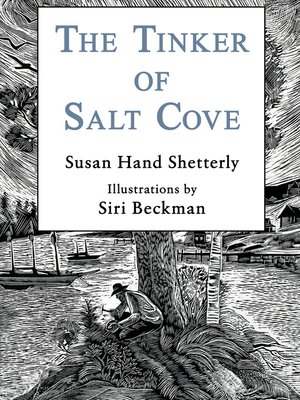 The Tinker of Salt Cove by ISBN: 9780884480808This beautifully told romantic tale takes place at the end of the 19th century, and is based on the life of John Cling, tinker, as recorded in the annals of Sullivan, Maine. Inevitable changes are altering the lives of the inhabitants of this seacoast town. Their orderly ways, set by the tides and the seasons, are disturbed by the arrival of a mysterious stranger from England. Two adolescent girls, just becoming aware of adult concerns, observe him through the seasons as he tries to find a place for himself. (SLJ)
The Tinker of Salt Cove by ISBN: 9780884480808This beautifully told romantic tale takes place at the end of the 19th century, and is based on the life of John Cling, tinker, as recorded in the annals of Sullivan, Maine. Inevitable changes are altering the lives of the inhabitants of this seacoast town. Their orderly ways, set by the tides and the seasons, are disturbed by the arrival of a mysterious stranger from England. Two adolescent girls, just becoming aware of adult concerns, observe him through the seasons as he tries to find a place for himself. (SLJ)
 El Molinete Maravilloso by Inspirado po un modelo de helicóptero y animados por sus padres y hermana, los jóvenes Orville y Wilbur Wright intentan construir un helicóptero de chatarra de tamaño natural.
El Molinete Maravilloso by Inspirado po un modelo de helicóptero y animados por sus padres y hermana, los jóvenes Orville y Wilbur Wright intentan construir un helicóptero de chatarra de tamaño natural.Song y Juniper by
ISBN: 9781623344337Publication Date: 2012-11-29Juniper es un Ligre, medio-leon, medio-tigre, y es mi mejor amigo. Nos encanta cuidar el uno del otro, y sentarnos debajo de un árbol.María Molina y Los Días de Los Muertos by
ISBN: 9781681864501Publication Date: 2015-09-12Es el 31 de octubre, el primero de los Días de los Muertos en México, y María Molina y su familia estan en el cementerio para honrar a su hermano pequeño, Pablo, que murio con solo unos meses de edad. Una vela brilla en la noche oscura, y en la tumba de Pablo han puesto sus juguetes favoritos, un poco de chocolate, una calavera de azúcar, y un pequeño 'Pan de los Muertos.' Por todo México, otras familias estan haciendo lo mismo; Los Días de los Muertos, un festival de tres días, es una de las fiestas más importantes de México.

